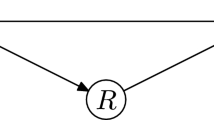Abstract
In this paper, an ARQ Go-Back-N protocol with time-out mechanism is studied. Transmissions on both the forward and the reverse channels are assumed to be subject to Markovian errors. A recently developed approach, based on renewal theory, is further extended and the steady state average number of packets in the ARQ system is evaluated. This allows us to determine analytically both throughput and transmission delay of the system. Simulation results, that confirm the analysis, are also presented. Based on the analysis, the trade-off involved in the choice of the time-out parameter is identified and discussed.
Similar content being viewed by others
References
D. Bertsekas and R. Gallager, Data Networks (Prentice-Hall, 1992).
L.F. Chang, Throughput estimation of ARQ protocols for a Rayleigh fading channel using fade-and interfade-duration statistics, IEEE Trans. Vehicular Technol. 40 (February1991) 223–229.
Y.J. Cho and C.K. Un, Performance analysis of ARQ error controls under Markovian block error pattern, IEEE Trans. Commun. 42 (February–April 1994) 2051–2061.
J.C.-J. Chuang, Comparison of two ARQ protocols in a Rayleigh fading channel, IEEE Trans. Vehicular Technol. 39 (November 1990) 367–373.
E.N. Gilbert, Capacity of a burst-noise channel, Bell System Tech. Journal 39 (September 1960) 1253–1266.
R.A. Howard, Dynamic Probabilistic Systems (Wiley, New York, 1971).
S.R. Kim and C.K. Un, Throughput analysis for two ARQ schemes using combined transition matrix, IEEE Trans. Commun. 40 (November 1992) 1679–1683.
S. Lin et al., Automatic-repeat-request error control schemes, IEEE Commun. Mag. 22(12) (December 1984) 5–17.
D.L. Lu and J.F. Chang, Analysis of ARQ protocols via signal flow graphs, IEEE Trans. Commun. 37 (March 1989) 245–251.
S.H. Ross, Stochastic Processes (Wiley, New York, 1983).
M. Zorzi and R.R. Rao, Throughput analysis of ARQ Go-Back-N protocol in Markov channels with unreliable feedback, in: ’95 (June 1995) pp. 1232–1237.
M. Zorzi and R.R. Rao, Performance of ARQ Go-Back-N protocol in Markov channels with unreliable feedback: Delay analysis, in: ’95 (November 1995) pp. 481–485.
M. Zorzi and R.R. Rao, On the use of renewal theory in the analysis of ARQ protocols, IEEE Trans. Commun. 44 (September 1996) 1077–1081.
M. Zorzi, R.R. Rao and L.B. Milstein, On the accuracy of a first-order Markov model for data block transmission on fading channels, in: ’95 (November 1995) pp. 211–215.
M. Zorzi, R.R. Rao and L.B. Milstein, ARQ error control for fading mobile radio channels, IEEE Trans. Vehicular Technol. 46 (May 1997) 445–455.
Author information
Authors and Affiliations
Rights and permissions
About this article
Cite this article
Zorzi, M., Rao, R.R. Performance of ARQ Go-Back-N protocol in Markov channels with unreliable feedback. Mobile Networks and Applications 2, 183–193 (1997). https://doi.org/10.1023/A:1013628616059
Issue Date:
DOI: https://doi.org/10.1023/A:1013628616059




